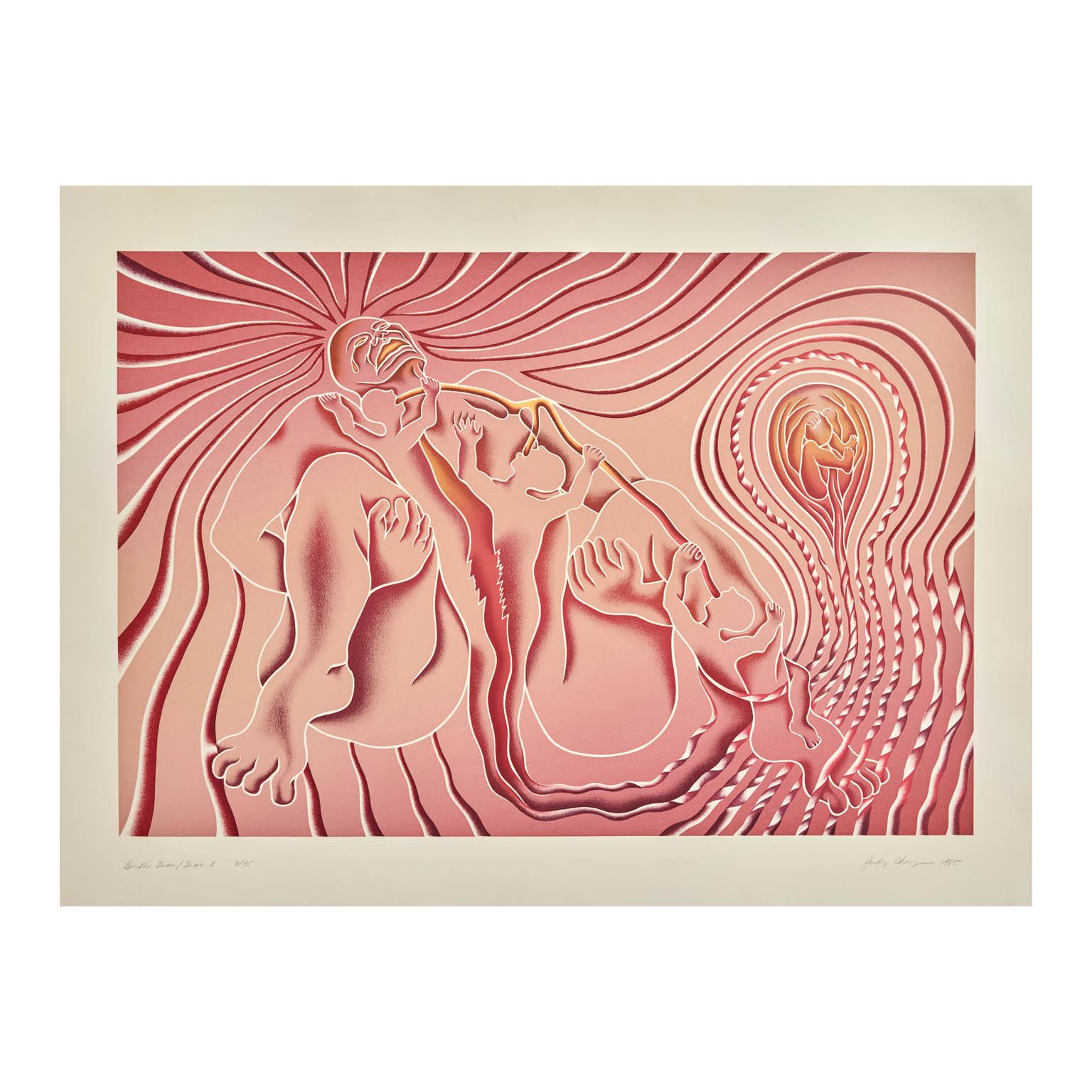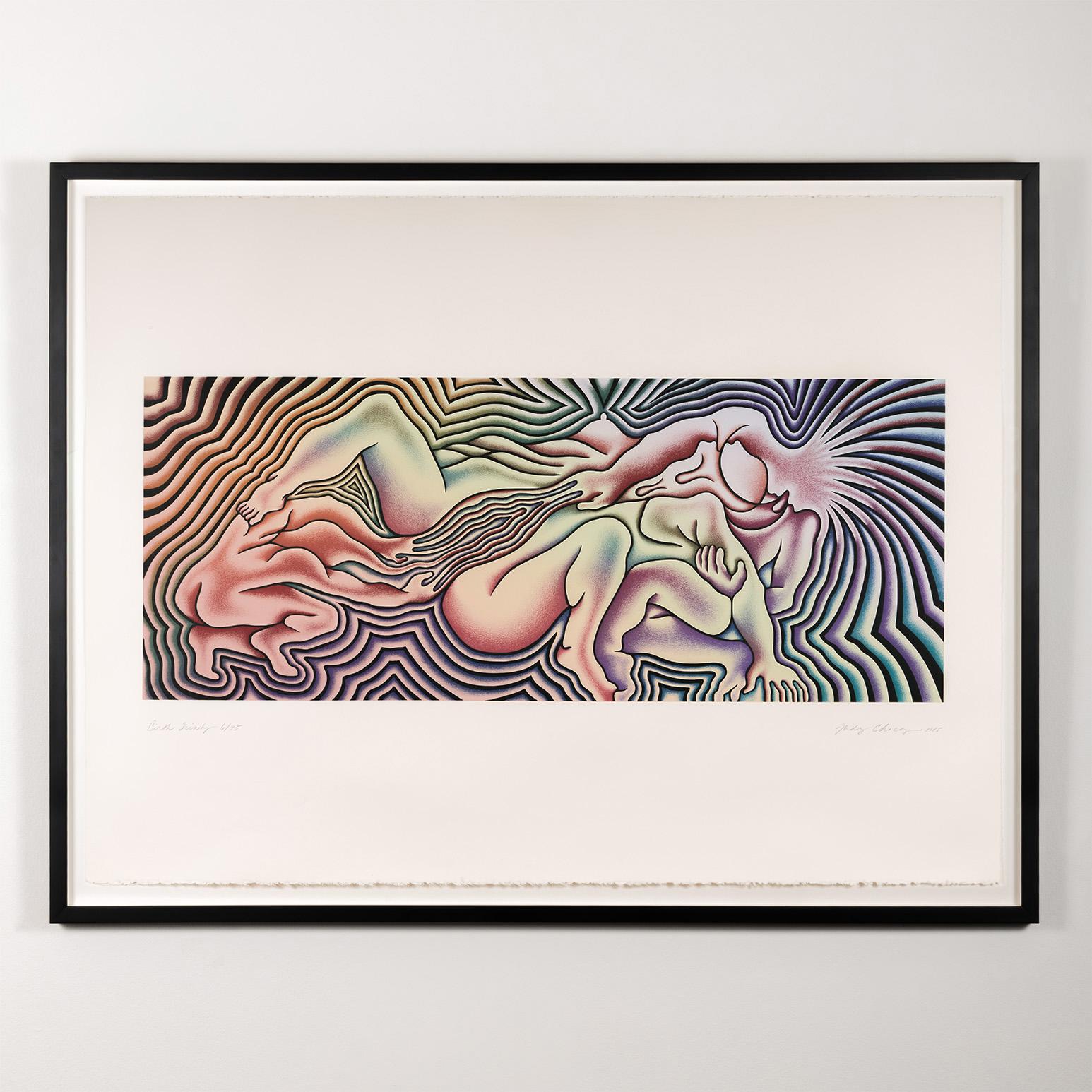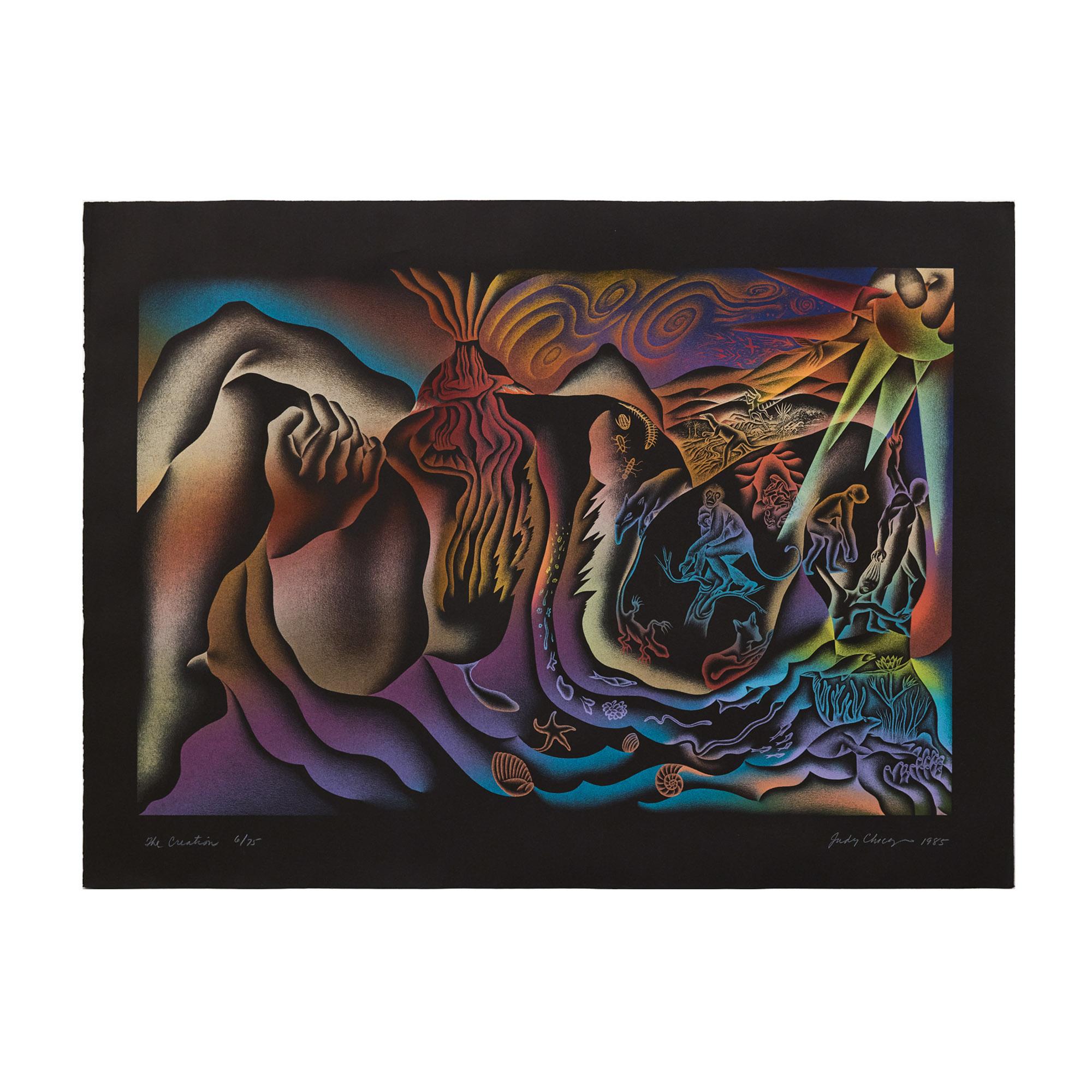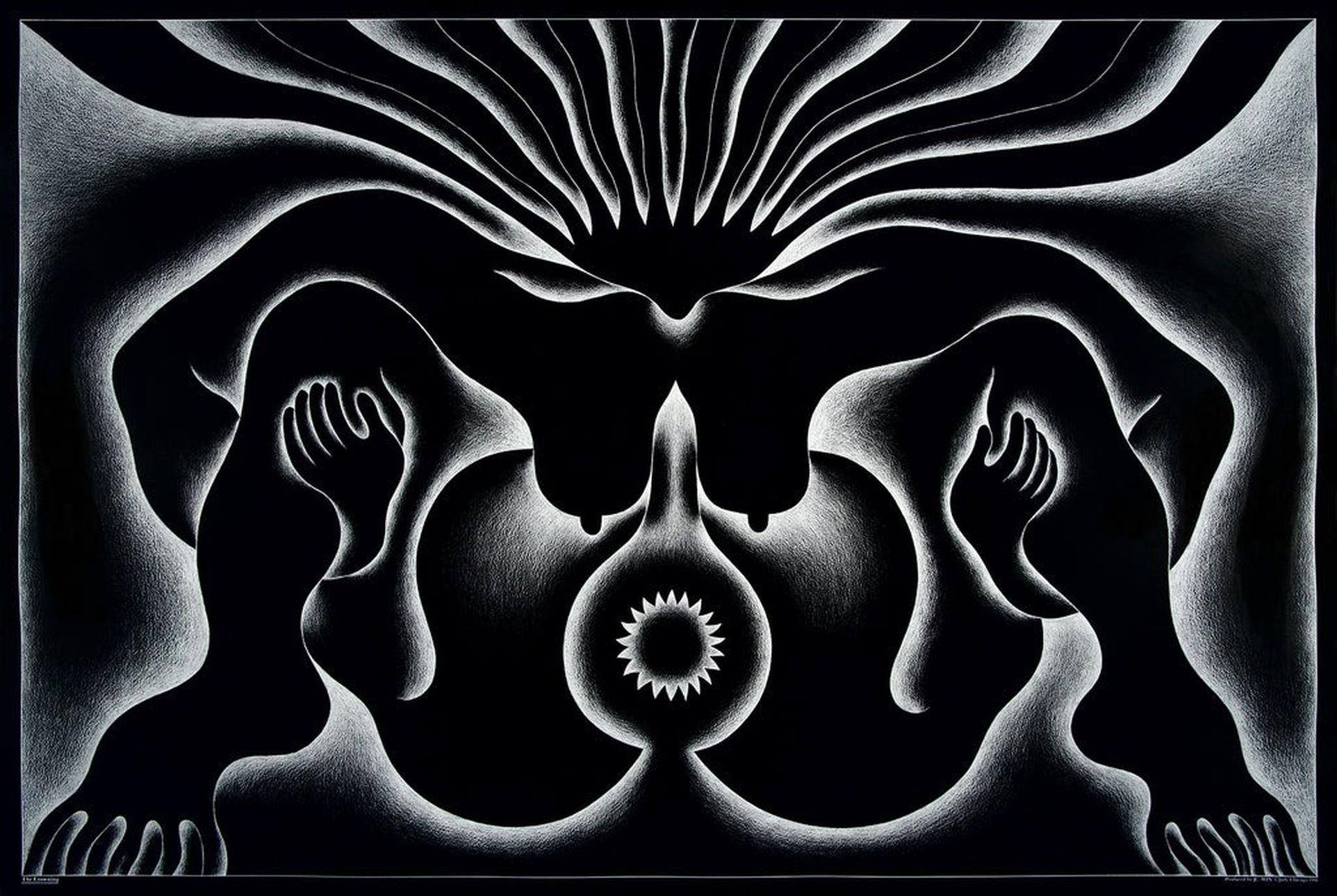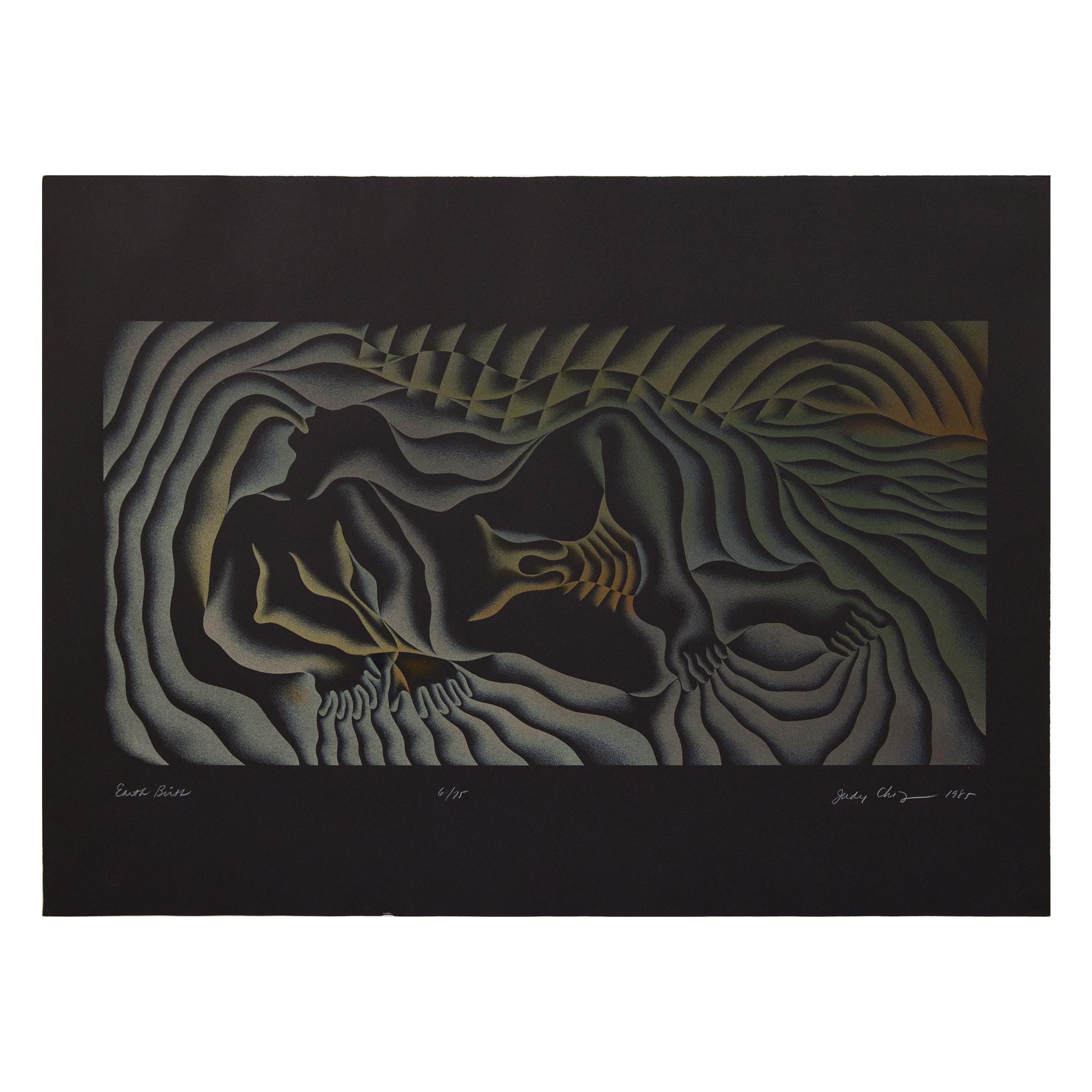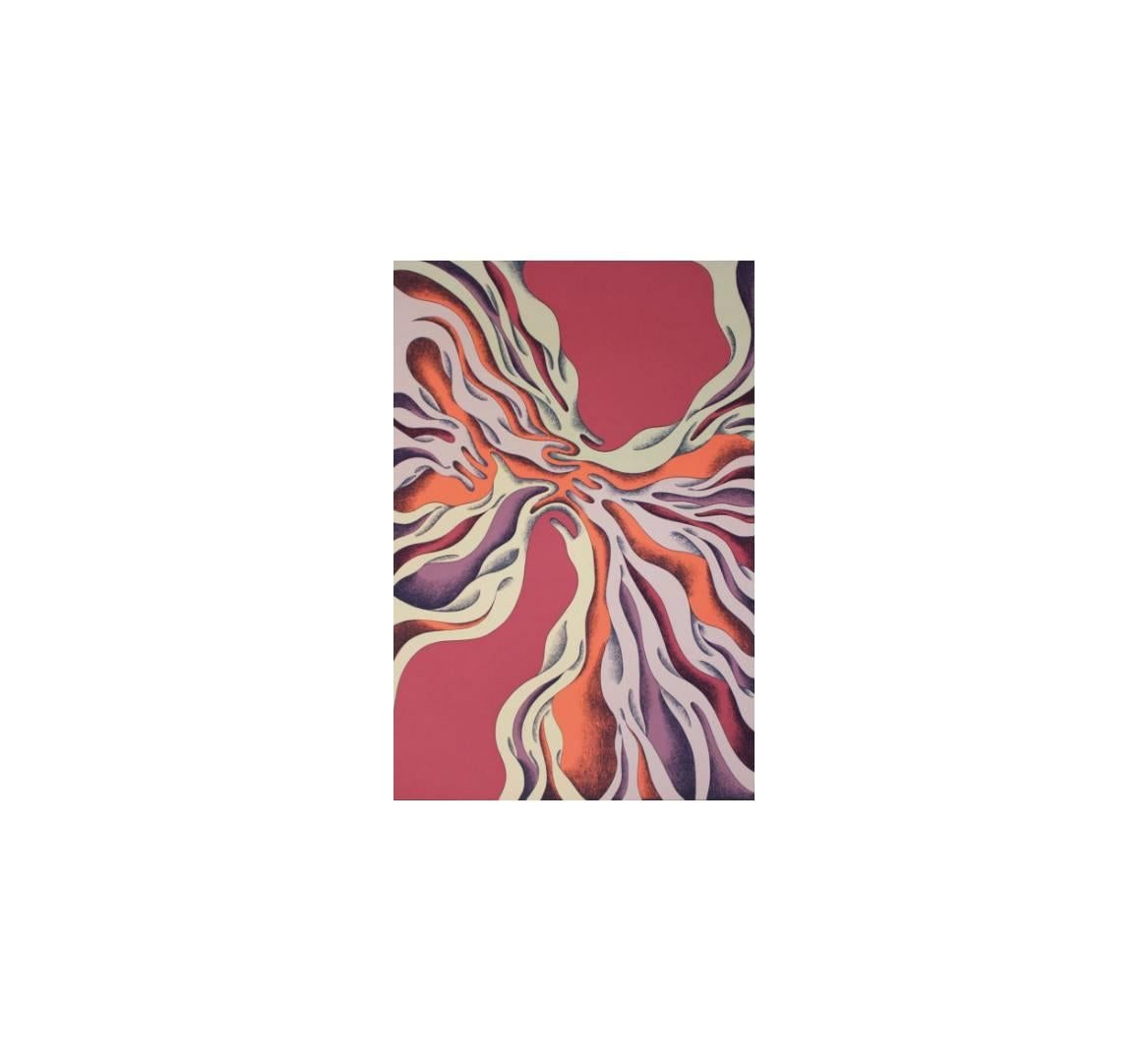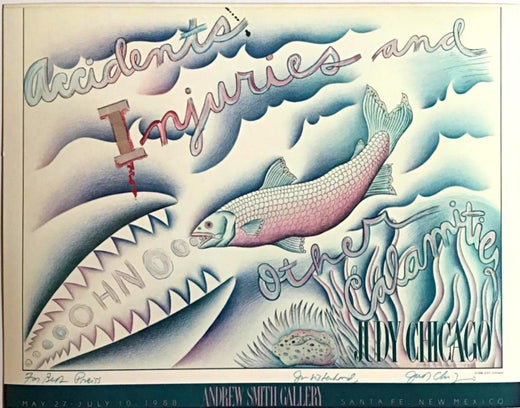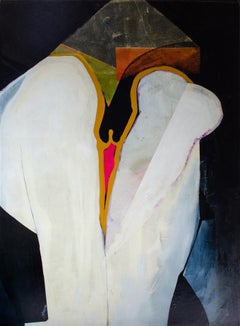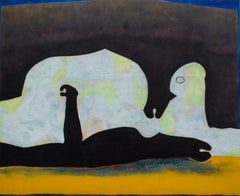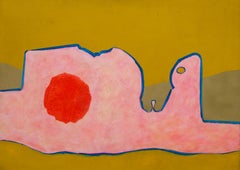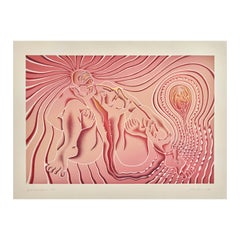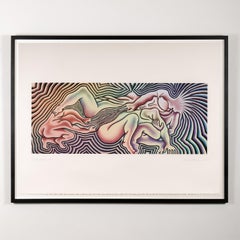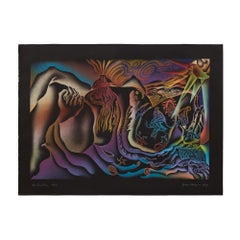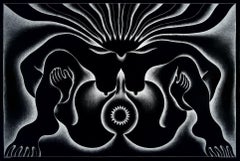Items Similar to "Birth Tear/Tear" Judy Chicago, 1985 Abstracted Surreal Figure Giving Birth
Want more images or videos?
Request additional images or videos from the seller
1 of 10
Judy Chicago"Birth Tear/Tear" Judy Chicago, 1985 Abstracted Surreal Figure Giving Birth1985
1985
$6,800
$8,50020% Off
£5,139.96
£6,424.9520% Off
€5,906.73
€7,383.4120% Off
CA$9,468.96
CA$11,836.2020% Off
A$10,533.83
A$13,167.2920% Off
CHF 5,521.96
CHF 6,902.4620% Off
MX$128,720.81
MX$160,901.0120% Off
NOK 70,315.33
NOK 87,894.1620% Off
SEK 66,192.16
SEK 82,740.1920% Off
DKK 44,091.46
DKK 55,114.3220% Off
Shipping
Retrieving quote...The 1stDibs Promise:
Authenticity Guarantee,
Money-Back Guarantee,
24-Hour Cancellation
About the Item
Judy Chicago
Birth Tear/Tear, 1985
Signed, dated, and numbered in margin
Serigraph on Stonehenge Natural White
Image 25 x 35 inches
Sheet 30 x 40 inches
Judy Chicago’s “Birth Tear/Tear” is one of the most iconic images from her “Birth Series,” which has been featured extensively in museums and galleries. This image relates to Chicago’s imagery embracing the truth and beauty of being female; the birth cavity/flower/place of creation, where life is both fertilized and delivered in the natural world.
Born Judy Cohen in Chicago, Illinois, in 1939, Chicago attended the Art Institute of Chicago and the University of California, Los Angeles. Chicago’s early work was Minimalist, and she was part of the landmark Primary Structures exhibition in 1966 at The Jewish Museum in New York. She turned to feminist content in the late 1960s. At this time she changed her last name to Chicago, the location of her birth.
Believing in the need for a feminist pedagogy for female art students, Chicago began the first Feminist Art Program at California State University, Fresno, in 1970. The following year, with artist Miriam Schapiro, she co-founded the Feminist Art Program at California Institute of the Arts, Valencia. Womanhouse (1972), a collaborative installation the two artists created with their students, transformed an abandoned building into a house representative of women’s experiences.
Chicago is perhaps best known for her iconic The Dinner Party (1974–1979), which celebrates women’s history through place settings designed for 39 important women. The monumental, collaborative project incorporates traditional women’s crafts such as embroidery, needlepoint, and ceramics.
Chicago’s work has continued to address themes from women’s lives with The Birth Project (1980–1985) and The Holocaust Project (1985–1993). She is a prolific lecturer and writer, and she has taught at Duke and Indiana Universities and the University of North Carolina at Chapel Hill. Her numerous awards include grants from the National Endowment for the Arts and the Getty Foundation and four honorary doctorates. She currently resides with her husband, photographer Donald Woodman, with whom she collaborates on artistic and teaching opportunities.
- Creator:Judy Chicago (1939, American)
- Creation Year:1985
- Dimensions:Height: 25 in (63.5 cm)Width: 33 in (83.82 cm)
- More Editions & Sizes:EditionPrice: $8,500
- Medium:
- Movement & Style:
- Period:
- Condition:
- Gallery Location:New York, NY
- Reference Number:1stDibs: LU1841214812682
Judy Chicago
Judy Chicago (born 1939) is an American feminist artist, art educator, and writer known for her large collaborative art installation pieces about birth and creation images, which examine the role of women in history and culture. Chicago's work incorporates a variety of artistic skills, such as needlework, counterbalanced with labor-intensive skills such as welding and pyrotechnics. Chicago's most well known work is The Dinner Party, which is permanently installed in the Elizabeth A. Sackler Center for Feminist Art at the Brooklyn Museum. Her work is in the collections of the British Museum, Metropolitan Museum of Art (New York), National Gallery (Washington DC), LACMA, Hammer Museum, San Francisco Museum of Modern Art, and Tate Modern.
About the Seller
5.0
Platinum Seller
Premium sellers with a 4.7+ rating and 24-hour response times
Established in 2022
1stDibs seller since 2022
114 sales on 1stDibs
Typical response time: <1 hour
- ShippingRetrieving quote...Shipping from: New York, NY
- Return Policy
Authenticity Guarantee
In the unlikely event there’s an issue with an item’s authenticity, contact us within 1 year for a full refund. DetailsMoney-Back Guarantee
If your item is not as described, is damaged in transit, or does not arrive, contact us within 7 days for a full refund. Details24-Hour Cancellation
You have a 24-hour grace period in which to reconsider your purchase, with no questions asked.Vetted Professional Sellers
Our world-class sellers must adhere to strict standards for service and quality, maintaining the integrity of our listings.Price-Match Guarantee
If you find that a seller listed the same item for a lower price elsewhere, we’ll match it.Trusted Global Delivery
Our best-in-class carrier network provides specialized shipping options worldwide, including custom delivery.More From This Seller
View All"Erotic #1 (Cronus Sex)" David Hare, Surrealist Abstract Composition
By David Hare
Located in New York, NY
David Hare
Erotic #1 (Cronus Sex), 1970
Acrylic and paper collage on linen
68 x 51 inches
“Freedom is what we want,” David Hare boldly stated in 1965, but then he added the caveat, ...
Category
1970s Abstract Abstract Paintings
Materials
Linen, Paper, Acrylic
"Cronus Asleep in the Cave" David Hare, Large Abstract Surrealist Composition
By David Hare
Located in New York, NY
David Hare
Cronus Asleep in the Cave, 1971
Acrylic on linen
55 x 67 inches
“Freedom is what we want,” David Hare boldly stated in 1965, but then he added the caveat, “and what we are most afraid of.” No one could accuse David Hare of possessing such fear. Blithely unconcerned with the critics’ judgments, Hare flitted through most of the major art developments of the mid-twentieth century in the United States. He changed mediums several times; just when his fame as a sculptor had reached its apogee about 1960, he switched over to painting. Yet he remained attached to surrealism long after it had fallen out of official favor. “I can’t change what I do in order to fit what would make me popular,” he said. “Not because of moral reasons, but just because I can’t do it; I’m not interested in it.”
Hare was born in New York City in 1917; his family was both wealthy and familiar with the world of modern art. Meredith (1870-1932), his father, was a prominent corporate attorney. His mother, Elizabeth Sage Goodwin (1878-1948) was an art collector, a financial backer of the 1913 Armory Show, and a friend of artists such as Constantin Brancusi, Walt Kuhn, and Marcel Duchamp.
In the 1920s, the entire family moved to Santa Fe, New Mexico and later to Colorado Springs, in the hope that the change in altitude and climate would help to heal Meredith’s tuberculosis. In Colorado Springs, Elizabeth founded the Fountain Valley School where David attended high school after his father died in 1932. In the western United States, Hare developed a fascination for kachina dolls and other aspects of Native American culture that would become a recurring source of inspiration in his career.
After high school, Hare briefly attended Bard College (1936-37) in Annandale-on-Hudson. At a loss as to what to do next, he parlayed his mother’s contacts into opening a commercial photography studio and began dabbling in color photography, still a rarity at the time [Kodachrome was introduced in 1935]. At age 22, Hare had his first solo exhibition at Walker Gallery in New York City; his 30 color photographs included one of President Franklin Roosevelt.
As a photographer, Hare experimented with an automatist technique called “heatage” (or “melted negatives”) in which he heated the negative in order to distort the image. Hare described them as “antagonisms of matter.” The final products were usually abstractions tending towards surrealism and similar to processes used by Man Ray, Raoul Ubac, and Wolfgang Paalen.
In 1940, Hare moved to Roxbury, CT, where he fraternized with neighboring artists such as Alexander Calder and Arshile Gorky, as well as Yves Tanguy who was married to Hare’s cousin Kay Sage, and the art dealer Julian Levy. The same year, Hare received a commission from the American Museum of Natural History to document the Pueblo Indians. He traveled to Santa Fe and, for several months, he took portrait photographs of members of the Hopi, Navajo, and Zuni tribes that were published in book form in 1941.
World War II turned Hare’s life upside down. He became a conduit in the exchange of artistic and intellectual ideas between U.S. artists and the surrealist émigrés fleeing Europe. In 1942, Hare befriended Andre Breton, the principal theorist of surrealism. When Breton wanted to publish a magazine to promote the movement in the United States, he could not serve as an editor because he was a foreign national. Instead, Breton selected Hare to edit the journal, entitled VVV [shorth for “Victory, Victory, Victory”], which ran for four issues (the second and third issues were printed as a single volume) from June 1942 to February 1944. Each edition of VVV focused on “poetry, plastic arts, anthropology, sociology, (and) psychology,” and was extensively illustrated by surrealist artists including Giorgio de Chirico, Roberto Matta, and Yves Tanguy; Max Ernst and Marcel Duchamp served as editorial advisors.
At the suggestion of Jacqueline Lamba...
Category
1970s Abstract Paintings
Materials
Linen, Acrylic
"Cronus Asleep in the Cave" David Hare, Mythological Surrealist Composition
By David Hare
Located in New York, NY
David Hare
Cronus Asleep in the Cave, 1971
Acrylic on board
27 1/2 x 38 1/4 inches
“Freedom is what we want,” David Hare boldly stated in 1965, but then he added the caveat, “and what we are most afraid of.” No one could accuse David Hare of possessing such fear. Blithely unconcerned with the critics’ judgments, Hare flitted through most of the major art developments of the mid-twentieth century in the United States. He changed mediums several times; just when his fame as a sculptor had reached its apogee about 1960, he switched over to painting. Yet he remained attached to surrealism long after it had fallen out of official favor. “I can’t change what I do in order to fit what would make me popular,” he said. “Not because of moral reasons, but just because I can’t do it; I’m not interested in it.”
Hare was born in New York City in 1917; his family was both wealthy and familiar with the world of modern art. Meredith (1870-1932), his father, was a prominent corporate attorney. His mother, Elizabeth Sage Goodwin (1878-1948) was an art collector, a financial backer of the 1913 Armory Show, and a friend of artists such as Constantin Brancusi, Walt Kuhn, and Marcel Duchamp.
In the 1920s, the entire family moved to Santa Fe, New Mexico and later to Colorado Springs, in the hope that the change in altitude and climate would help to heal Meredith’s tuberculosis. In Colorado Springs, Elizabeth founded the Fountain Valley School where David attended high school after his father died in 1932. In the western United States, Hare developed a fascination for kachina dolls and other aspects of Native American culture that would become a recurring source of inspiration in his career.
After high school, Hare briefly attended Bard College (1936-37) in Annandale-on-Hudson. At a loss as to what to do next, he parlayed his mother’s contacts into opening a commercial photography studio and began dabbling in color photography, still a rarity at the time [Kodachrome was introduced in 1935]. At age 22, Hare had his first solo exhibition at Walker Gallery in New York City; his 30 color photographs included one of President Franklin Roosevelt.
As a photographer, Hare experimented with an automatist technique called “heatage” (or “melted negatives”) in which he heated the negative in order to distort the image. Hare described them as “antagonisms of matter.” The final products were usually abstractions tending towards surrealism and similar to processes used by Man Ray, Raoul Ubac, and Wolfgang Paalen.
In 1940, Hare moved to Roxbury, CT, where he fraternized with neighboring artists such as Alexander Calder and Arshile Gorky, as well as Yves Tanguy who was married to Hare’s cousin Kay Sage, and the art dealer Julian Levy. The same year, Hare received a commission from the American Museum of Natural History to document the Pueblo Indians. He traveled to Santa Fe and, for several months, he took portrait photographs of members of the Hopi, Navajo, and Zuni tribes that were published in book form in 1941.
World War II turned Hare’s life upside down. He became a conduit in the exchange of artistic and intellectual ideas between U.S. artists and the surrealist émigrés fleeing Europe. In 1942, Hare befriended Andre Breton, the principal theorist of surrealism. When Breton wanted to publish a magazine to promote the movement in the United States, he could not serve as an editor because he was a foreign national. Instead, Breton selected Hare to edit the journal, entitled VVV [shorth for “Victory, Victory, Victory”], which ran for four issues (the second and third issues were printed as a single volume) from June 1942 to February 1944. Each edition of VVV focused on “poetry, plastic arts, anthropology, sociology, (and) psychology,” and was extensively illustrated by surrealist artists including Giorgio de Chirico, Roberto Matta, and Yves Tanguy; Max Ernst and Marcel Duchamp served as editorial advisors.
At the suggestion of Jacqueline Lamba...
Category
1970s Abstract Abstract Paintings
Materials
Acrylic
"Insiders Say Too Much is Enough" Lawrence Philp, Abstracted Surrealist Forms
Located in New York, NY
Lawrence Philp
Insiders Say Too Much is Enough
Signed lower left; titled on overlap
Oil on canvas
70 x 59 1/2 inches
Lawrence Philp, the son of Jamaican immigrants, studied at the ...
Category
1970s Surrealist Abstract Paintings
Materials
Canvas, Oil
"Cronus Asleep in the Cave" David Hare, Surrealist Mythological Composition
By David Hare
Located in New York, NY
David Hare
Cronus Asleep in the Cave, 1971
Acrylic, ink wash, graphite, paper collage on paper on board
26 x 35 inches
“Freedom is what we want,” David Hare boldly stated in 1965, b...
Category
1970s Abstract Abstract Paintings
Materials
Acrylic, Paper, Ink, Graphite
"Cronus Elephant" David Hare, Surrealist Abstract Composition Painting
By David Hare
Located in New York, NY
David Hare
Cronus Elephant, 1975
Acrylic on linen
82 x 60 inches
“Freedom is what we want,” David Hare boldly stated in 1965, but then he added the caveat, “and what we are most afr...
Category
1970s Abstract Abstract Paintings
Materials
Linen, Acrylic
You May Also Like
Birth Tear/Tear
By Judy Chicago
Located in Toronto, Ontario
Judy Chicago (b. 1939) is a world-renowned American artist and preeminent figure of the Feminist Art movement of the 1970s.
Throughout her career, Chicago has consistently challenge...
Category
1980s Contemporary Figurative Prints
Materials
Screen
Birth Trinity
By Judy Chicago
Located in Toronto, Ontario
Judy Chicago (b. 1939) is a world-renowned American artist and preeminent figure of the Feminist Art movement of the 1970s. Throughout her six-decade career, she has contested the ab...
Category
1980s Contemporary Figurative Prints
Materials
Screen
The Creation
By Judy Chicago
Located in Toronto, Ontario
Judy Chicago (b. 1939) is a world-renowned American artist and preeminent figure of the Feminist Art movement of the 1970s.
Throughout her career, Chicago has consistently challenge...
Category
1980s Contemporary Figurative Prints
Materials
Screen
“The Crowning” By Judy Chicago
By Judy Chicago
Located in London, GB
“The Crowning”
By Judy Chicago
From 1980 to 1985, Chicago worked on the Birth Project. Judy Chicago collaborated with more than 150 needle workers during the Birth Project to crea...
Category
2010s Contemporary Figurative Prints
Materials
Paper
Earth Birth
By Judy Chicago
Located in Toronto, Ontario
Judy Chicago (b. 1939) is a world-renowned American artist and preeminent figure of the Feminist Art movement of the 1970s.
Throughout her career, Chicago has challenged the (male-d...
Category
1980s Contemporary Figurative Prints
Materials
Screen
Reaching/Uniting/Becoming Free by Judy Chicago
By Judy Chicago
Located in Morton Grove, IL
Judy Chicago
Reaching/Uniting/Becoming Free
1979
Silkscreen
artist proof from the edition of 100
signed
dated
Very rare!
Born Judy Cohen in Chicago, Illinois, in 1939, Chicago att...
Category
1970s Abstract Abstract Prints
Materials
Screen
More Ways To Browse
Chicago Jewish
Vintage Feminist Art
Judys Vintage
Donald Grant
1960s Surreal Art
The Dinner Party
Duke University Vintage
The Dinner Party Painting
1960s Needlepoint
Stephen Kinder
Large Rectangle Paintings
Maine Glass
Modern Tiger Painting
The Dinner Party
Guatemala Paintings
Iran Oil On Canvas
Jack Johnson
Lime Green Abstract Art
